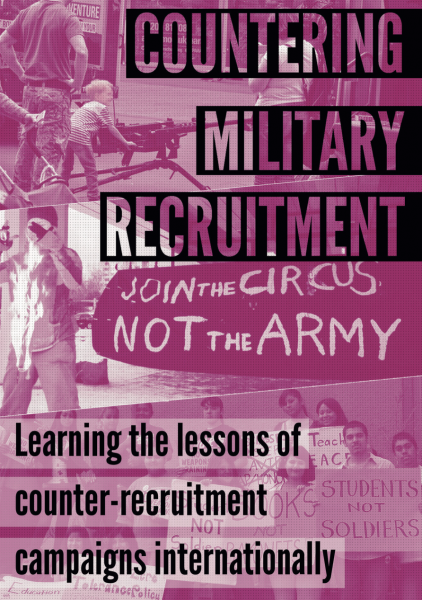The Military Enlistment Opportunity Act: a New Kind of Draft?

Rick Jahnkow
Originally posted on Draft Notices
It’s well established that many people who join the U.S. military do so because of their economic status. It could be that they do not see options for a civilian job that pays a livable wage, they cannot afford health insurance, or they believe they’ll never be able to go to college without financial aid from the Post-9/11 GI Bill. Whether this belief is accurate or based on an individual’s limited awareness of alternatives, military recruiters are effective at exploiting economic predicament to meet their monthly quotas. Many of us refer to it as economic conscription or the “poverty draft.” It is the reason why counter-recruitment groups spend much of their time and energy gathering and distributing information on alternative sources for job training and college financial aid.
Recruitment success rates have always been strongly affected by the economy, and the high unemployment rate since the economic crash of 2008 has made it much easier for the military to meet its enlistment quotas. If, on the other hand, the economy continues its gradual improvement, we can expect that recruiting will once again become difficult and the armed forces will be scrambling to find a larger pool of people to tap to fill their ranks. This looming problem has already been projected and mentioned to members of Congress by Pentagon representatives.
One group of disadvantaged youths that has always been out of reach for recruiters consists of undocumented immigrants brought to the U.S. when they were very young by their parents. They have gone through the school system and been culturally assimilated, yet they suffer economic hardship because their non-legal status handicaps their ability to get jobs, travel and attain higher education. A few states have passed legislation that alleviates some of these problems — e.g., allowing undocumented people to apply for driver’s licenses or receive state college financial aid — but the majority are unaffected by such legislation, and all live under the shadow of possible deportation because they do not have legal permanent residency (LPR) or citizenship.
Because of a policy change ordered by the Obama administration in 2012, such individuals can submit an application and, if qualified, be allowed to temporarily avoid deportation, apply for a Social Security number, and get official permission to work. Called the Deferred Action for Childhood Arrivals (DACA) program, it does not provide a path to legal permanent residency or citizenship. It is, essentially, only a policy to defer possible prosecution for being in the country illegally.
People with approved DACA status currently make up a very large pool of individuals (400,000 as of June 2013) who are military-age and could potentially meet enlistment standards. In the military’s eyes, they could be the difference between maintaining personnel levels at full strength or experiencing serious enlistment shortfalls when the economy improves and the civilian unemployment rate drops. The problem for the Pentagon is that current law only allows the armed forces to accept people with LPR or citizenship, so these individuals cannot be targeted for recruitment.
This could all change in a big way if a new bill, House Resolution 435, is passed by the U.S. Congress. Introduced by Representative Mike Coffman (R-Colo.) in January 2013, it would amend the law to allow individuals with DACA status to join the military and immediately jump to LPR status.
According to Coffman, “[To] maintain its elite requirements the military must expand its recruiting base to all of these young people I have met who want to serve but are unable to under current laws.”
Since immigrants in the military with LPR status can apply for citizenship in boot camp — skipping the five years that qualified civilian immigrants must wait to apply — this legislation would mean that the military would become a potential way for 400,000 people to quickly gain the secure status that would otherwise not be available to them. And unlike some versions of the DREAM Act proposal that has failed to pass Congress, H.R. 435 would offer NO alternative paths to citizenship for undocumented youths, ONLY the military route.
While it is the case that many of the hundreds of thousands of youths with DACA status would not pass the military’s physical and intelligence standards, does anyone think that the carrot of possible citizenship would not lead a huge percentage of them to apply for enlistment, especially when they are given no alternative citizenship paths to choose from, like college or community service?
If it passes, this would essentially be another form of conscription, one with a greater force fueling it than just economics. Call it the “deferred action draft” or “trapped immigrant call-up,” and watch as a new class of disadvantaged youths is exploited to maintain our global military reach.
H.R. 435 has 12 co-sponsors and is currently waiting for action in two committees of the House of Representatives: the Armed Services Military Personnel Subcommittee and the Judiciary Immigration and Border Security Subcommittee. For legislative information, visit www.congress.gov.
Information sources: Politico.com, 5/21/2013; theledger.com, 8/19/2013.
This article is from Draft NOtices, the newsletter of the Committee Opposed to Militarism and the Draft (http://www.comdsd.org/).
Countering Military Recruitment

WRI's new booklet, Countering Military Recruitment: Learning the lessons of counter-recruitment campaigns internationally, is out now. The booklet includes examples of campaigning against youth militarisation across different countries with the contribution of grassroot activists.
You can order a paperback version here.







